Learn how to cut green onions using three unique but simple techniques. Whether you need them for ramen bowls, baked potatoes, or fried rice, this guide will show you everything you need to know to garnish like a pro!
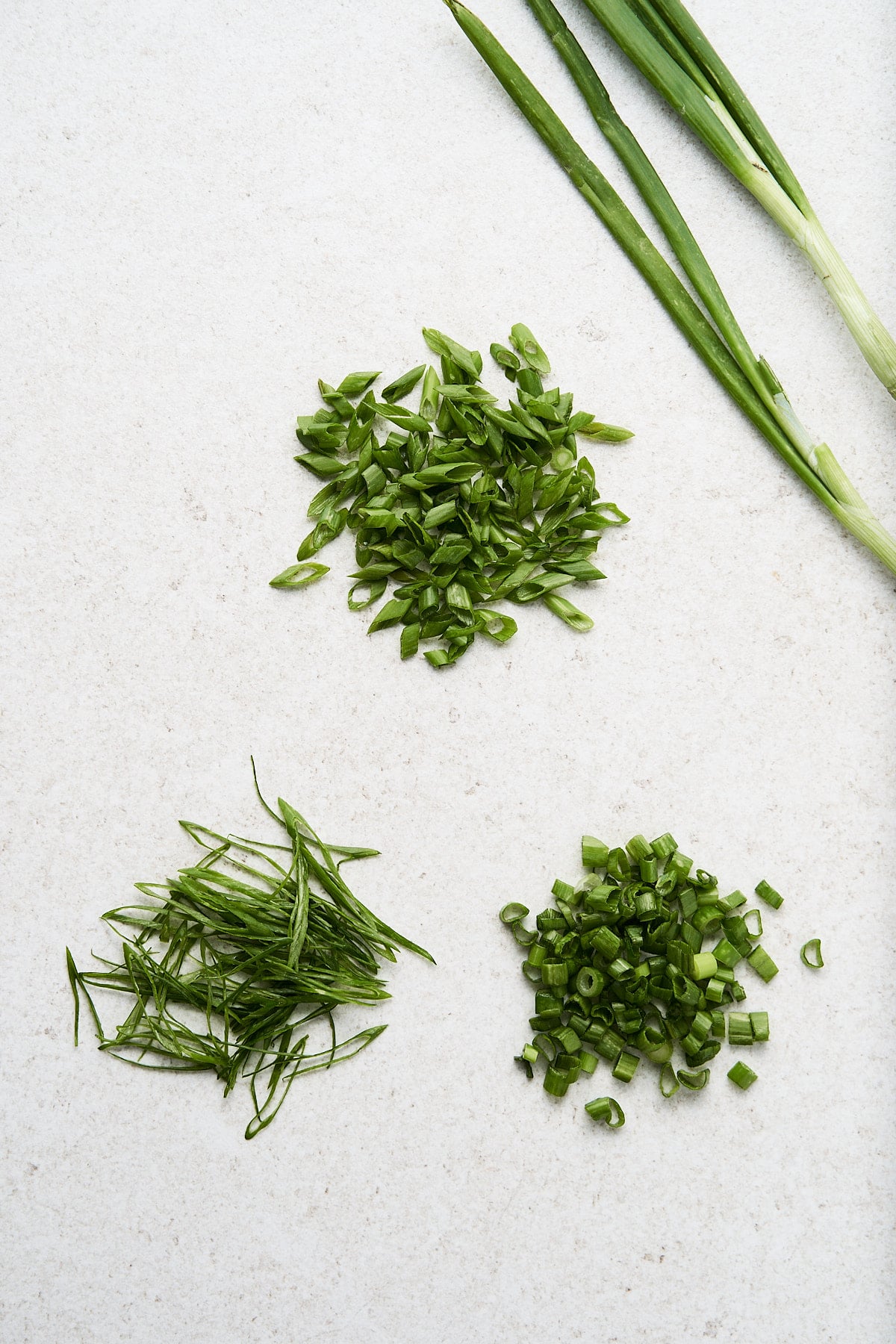
What Are Green Onions?
Green onions are a cultivar that belongs to the genus Allium, which also encompasses shallots, garlic, leeks, and chives. They have long, hollow green stalks with small white bulbs. Typically, you will find them sold in bunches at the grocery store.
From a seedling, the maturing plant grows stalks until each onion has multiple stalks sprouting from a single white-rooted base. In cooking, green onions are often used to garnish recipes like stews, soups, curries, pizzas, and the like to add pops of savoriness.
Scallions, Green onions & Spring Onions
There’s a lot of terminology in the world of onions, but these are the big three to know the difference between!
Scallions: The name given to an immature onion that is harvested before the white bulb begins to swell.
Green onions: Harvested later in the life cycle, green onions have a slightly swollen and oblong bulb. However, they are still immature compared to a fully grown onion. These are the most common green onion you’ll find at the store.
Spring onions: Harvested close to the same time as green onions. They’re known as spring onions because they’re generally planted in fall and harvested after winter. Since there’s more time to mature, spring onions usually have a round, more pronounced white bulb.
So, whether you want to know how to cut scallions, how to cut spring onions, or how to cut green onions, the process is quite similar! (Or explore the differences between green onions and chives.)
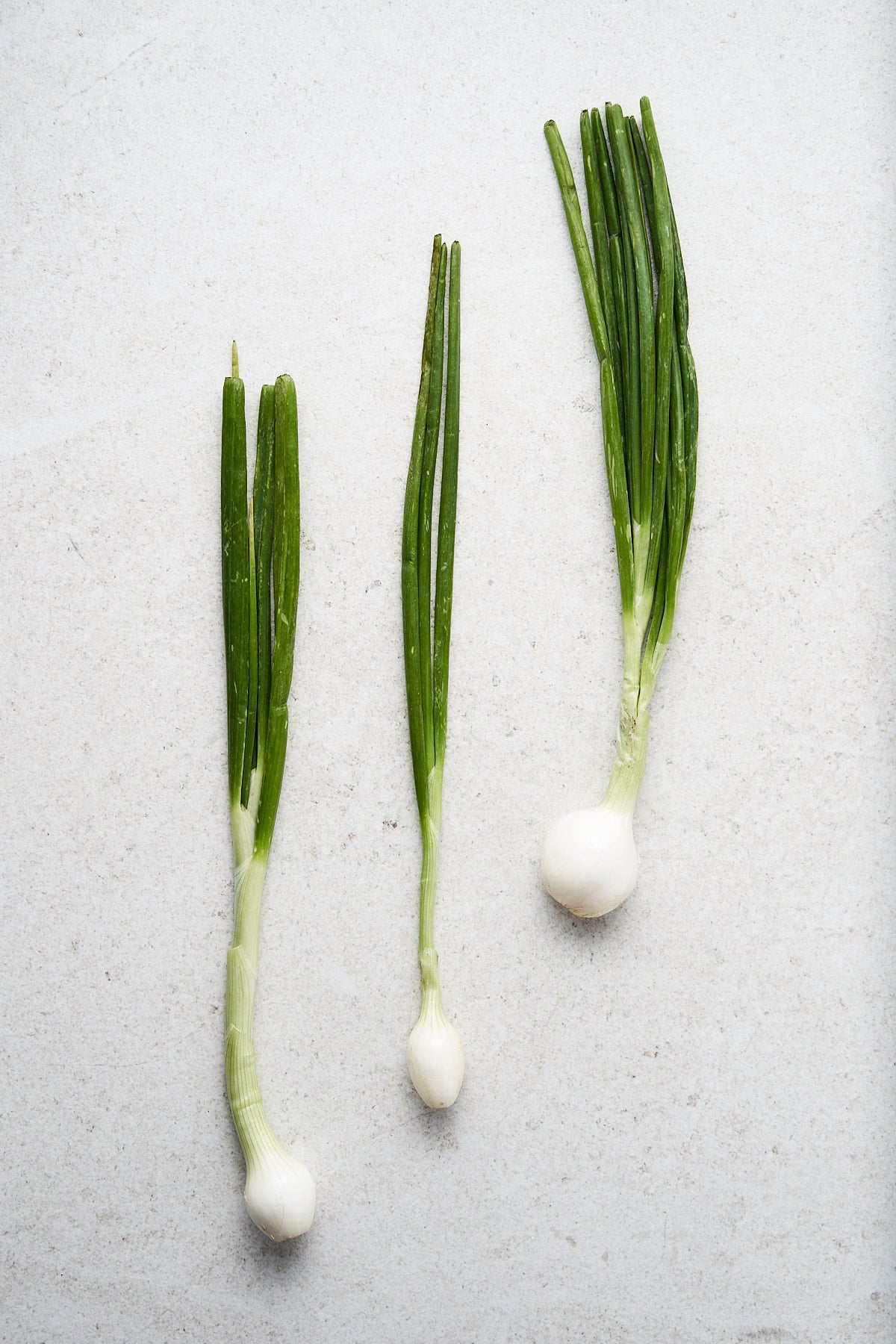
How to Cut Green onions
There are many techniques regarding how to cut spring onions. Depending on your needs, the green portion is generally reserved for garnishing while the more pungent white portion should be included in the cooking process.
Step 1: Prepare the green onions
Rinse away any large clumps of dirt, and peel away any slimy or wilty stems at the same time. If the ends appear dry or brown, trim them off using a sharp chef’s knife. Compost these pieces, or save them for homemade vegetable stock.
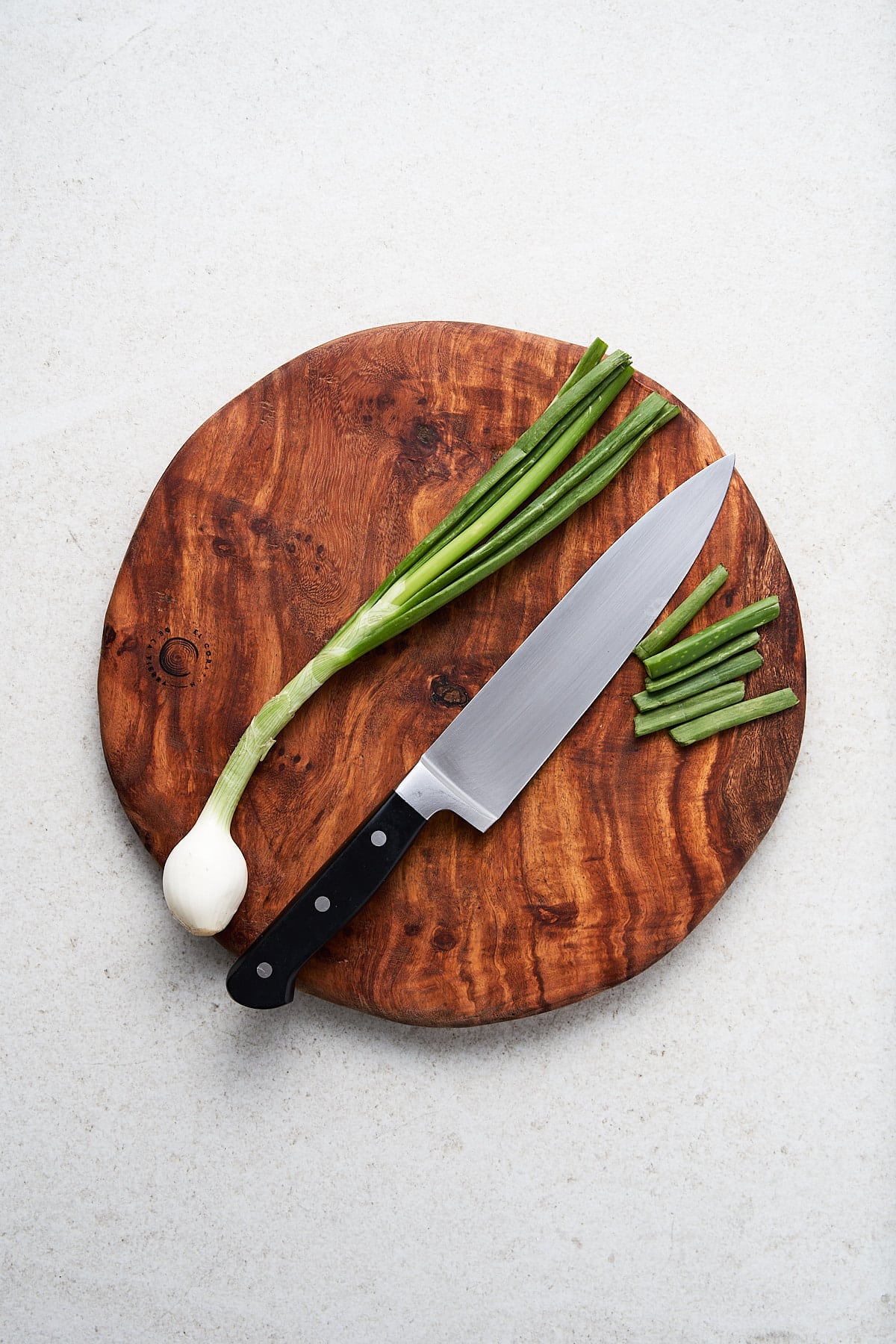
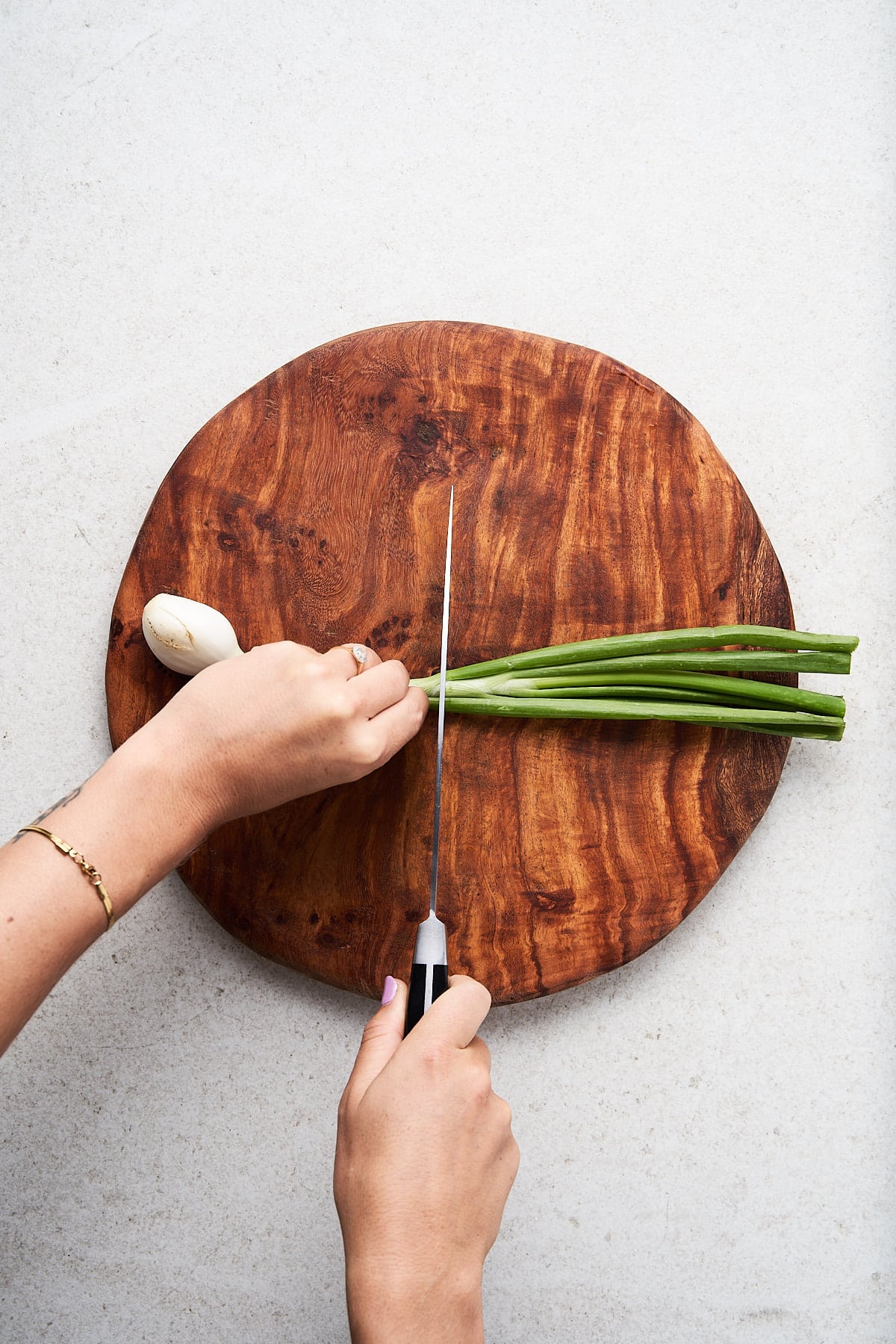
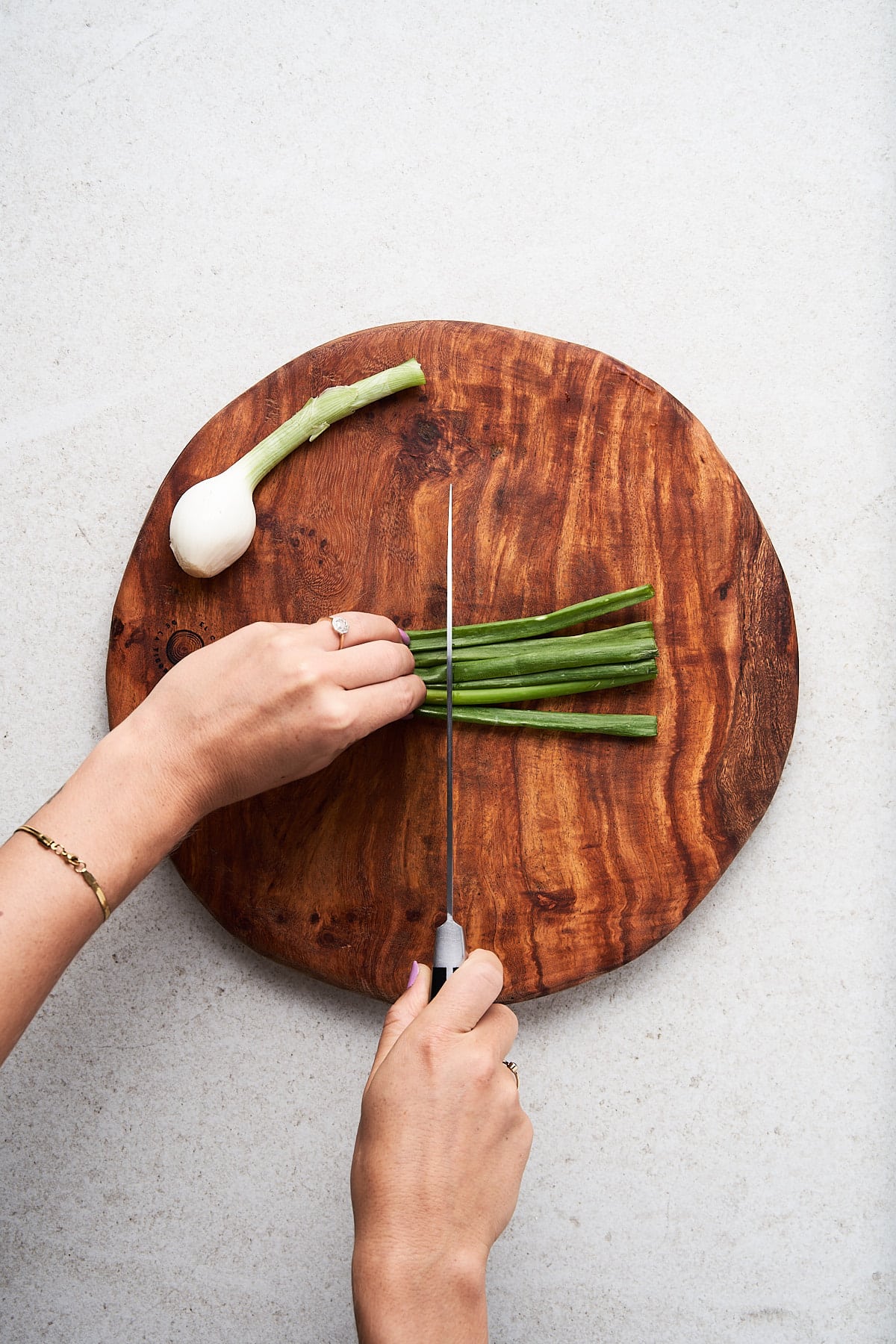
Cut where the green stems meet the lighter, tougher portion of the onion (see middle photo). Next, cut the green onions in half to make a shorter bunch, which is easier to work with.
Step 2: Cut the Green onions
When it comes to chopping the green onions, you’ve got three methods to choose from.
Straight Slice Method
Place the green onion stems horizontally on your cutting board. Grip the bunch with your non-dominant hand, pushing your knuckles forward to protect your fingers. With a sharp chef’s knife, slice at a 90-degree angle to the stems, forming straight sliced green onions.
Make sure to use a rocker motion with your knife so it slices all the way through the onions. Use straight sliced green onions as a garnish on dishes like baked potatoes, tofu salad, or pizza.
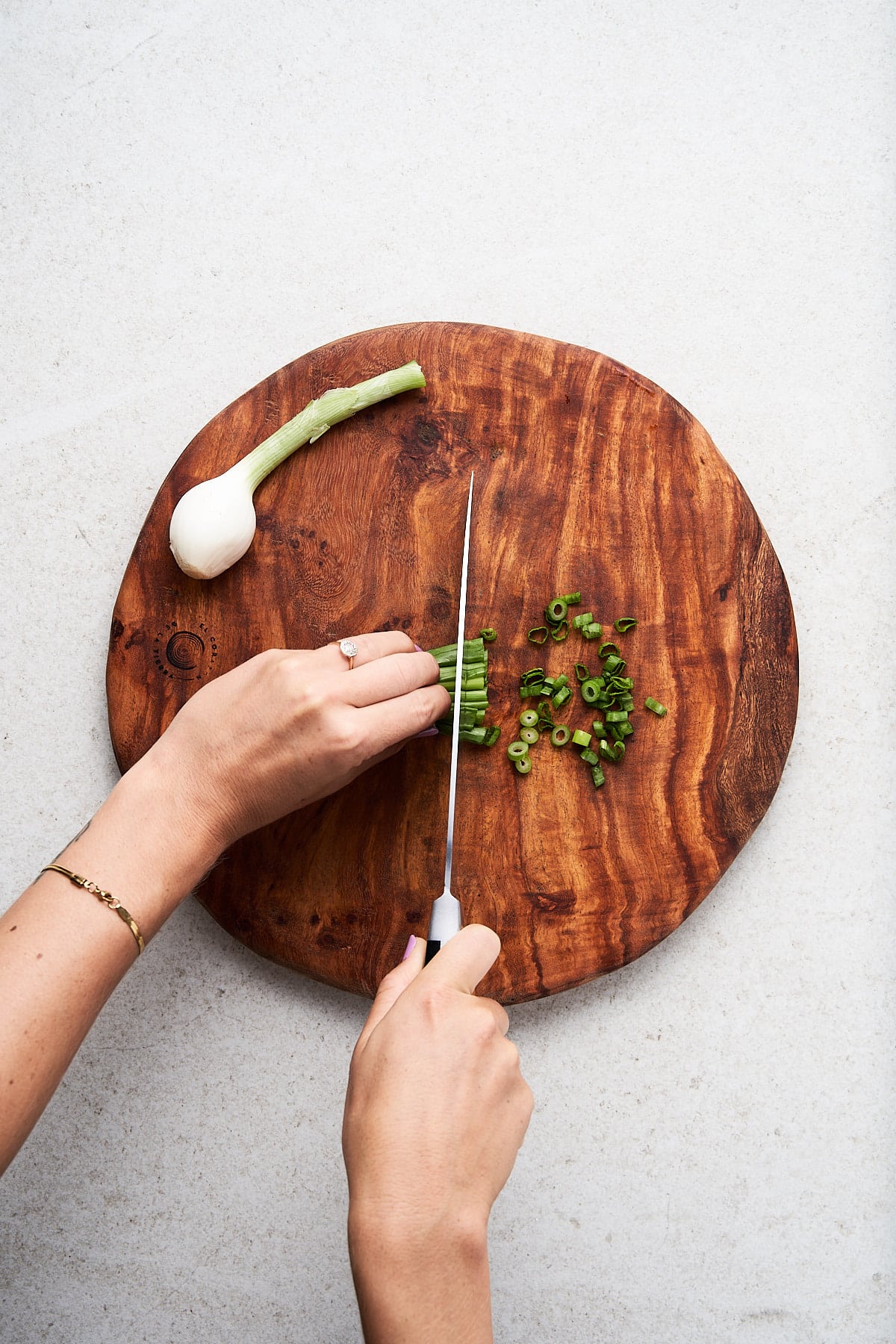
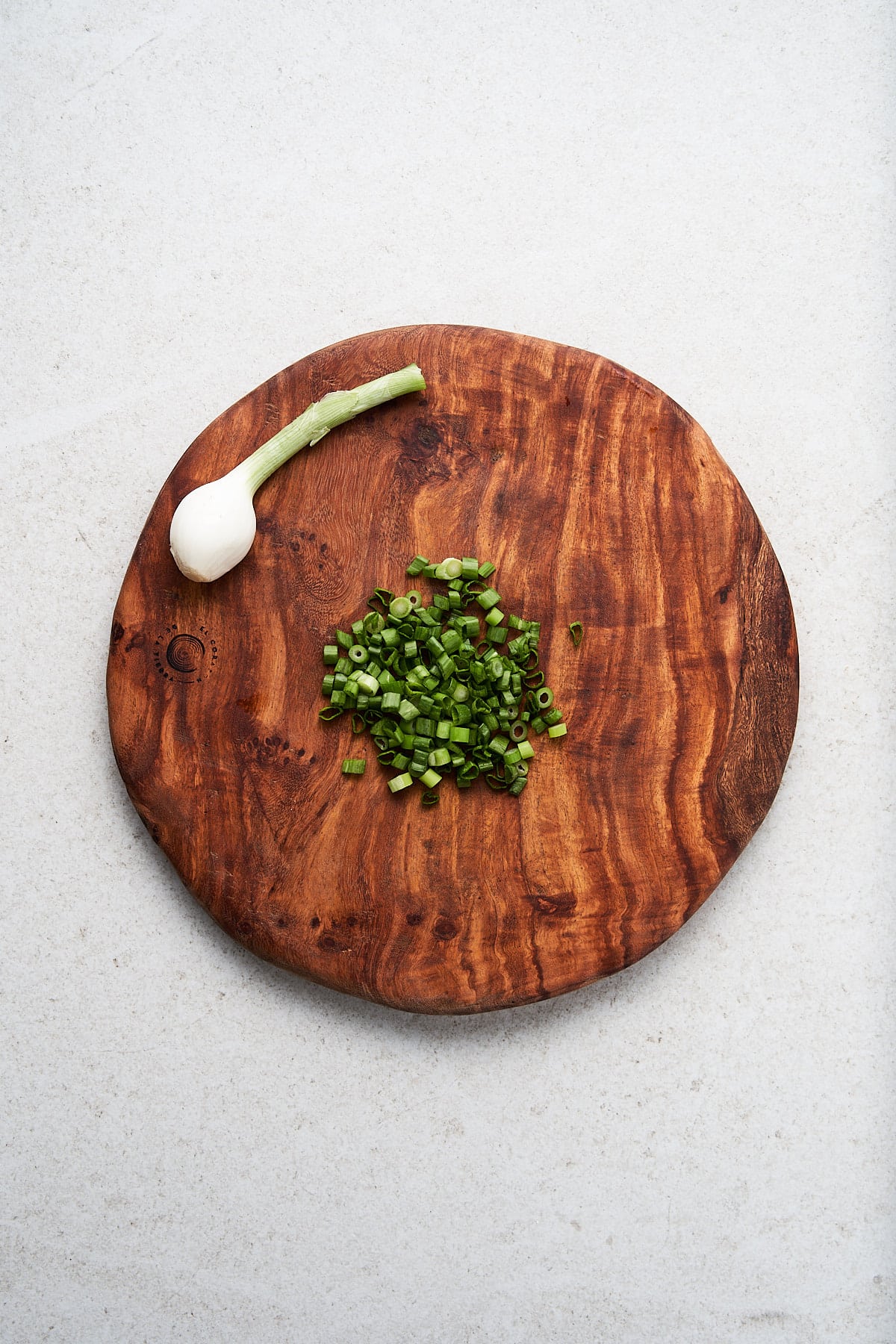
Bias Cut Method
Similarly to the straight-cut onions, grip the bunch with your non-dominant hand. Rotate your body or the bunch of green onions to about a 45-degree angle. Then, perform the same rocker motion to bias cut the green onions (angle cut).
Use bias cut green onions as a garnish on soups and stews, in fried rice, or on curries.
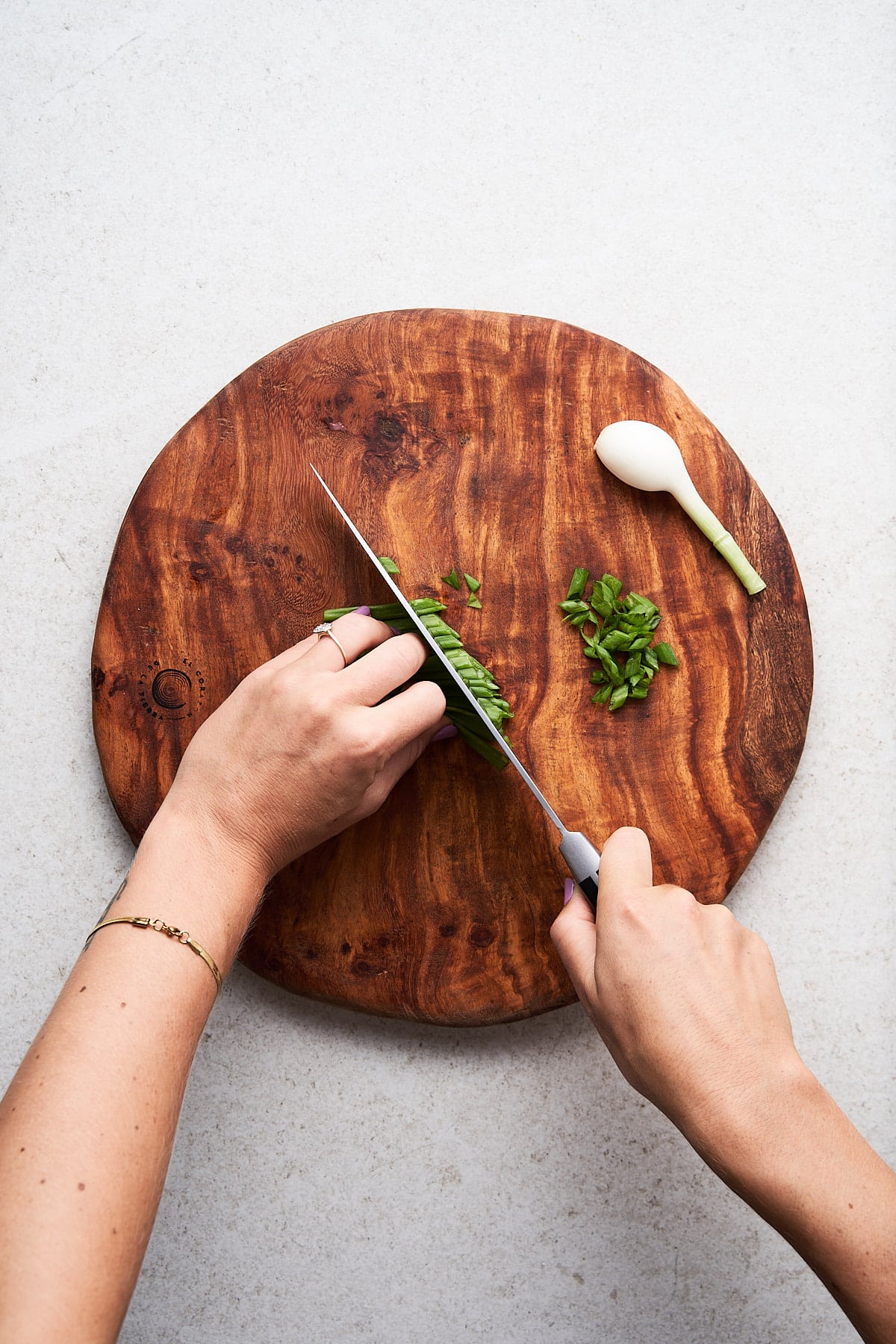
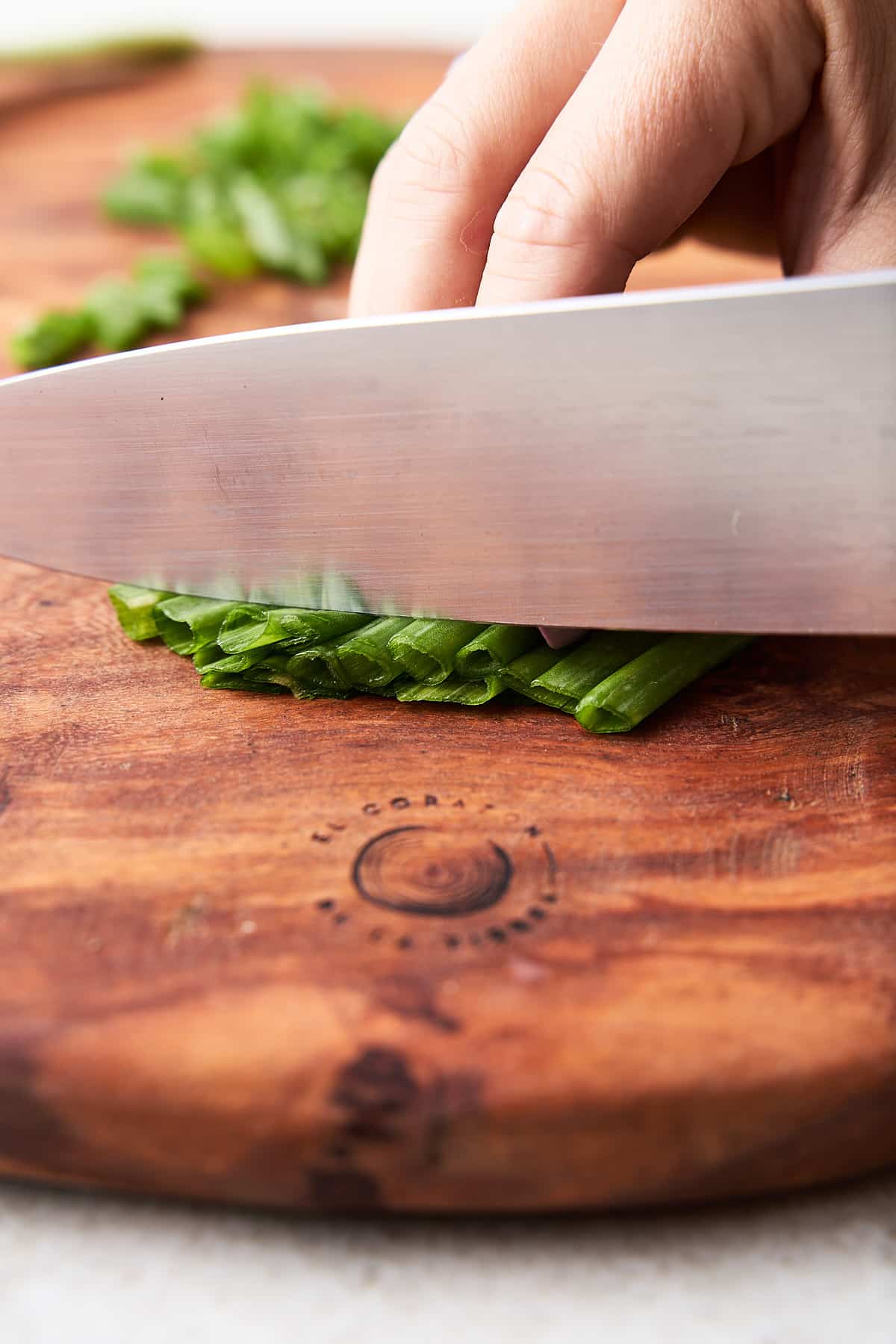
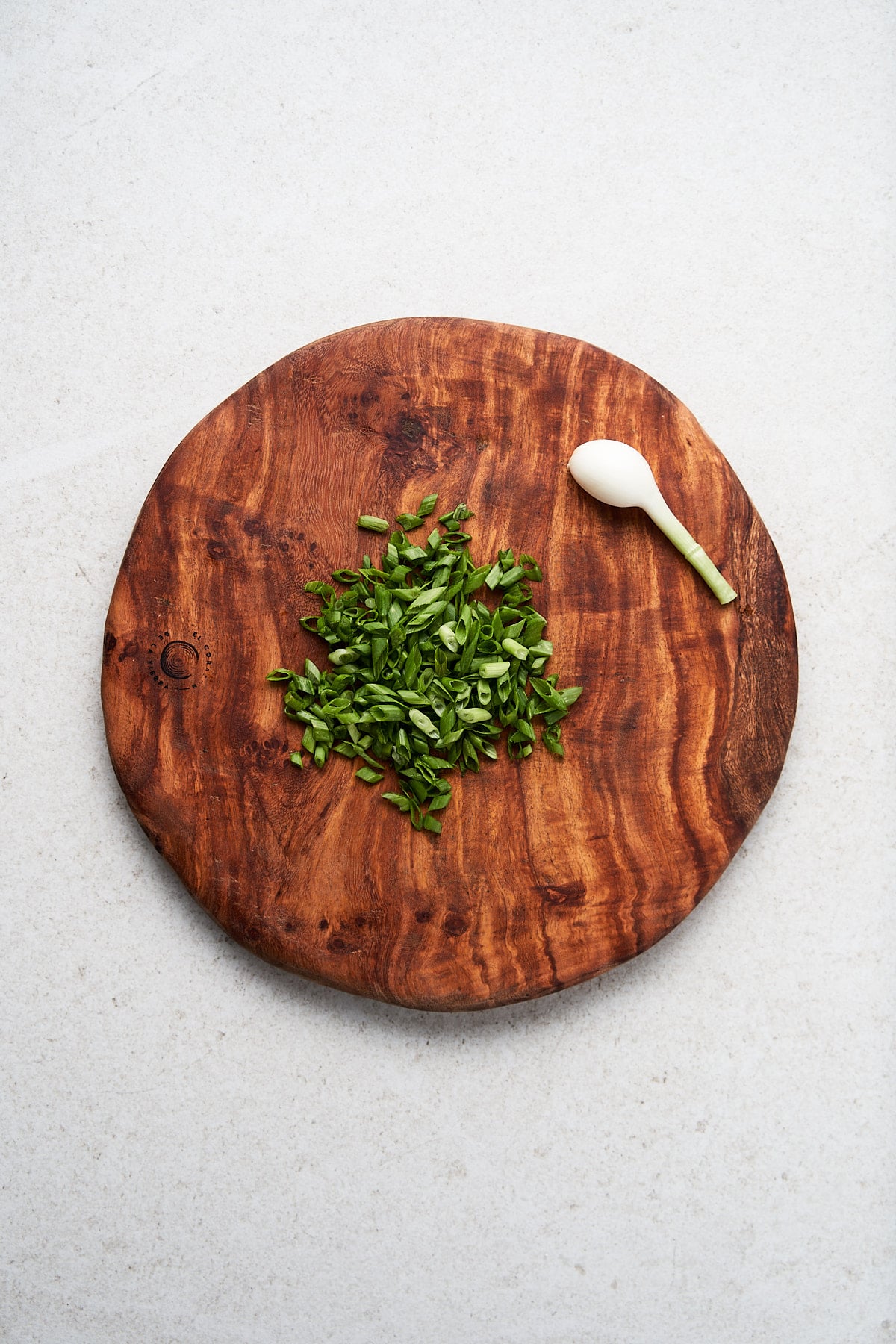
Thin Bias Cut Method
For this method, it’s easier to work with one stem at a time. Place the green onion stem vertically on your cutting board, then rotate it slightly or move your body so your hips are not twisted. At a steep angle, begin slicing the onion by dragging the knife towards your body.
Continue slicing all the way through the onion to form thin bias cut green onions. These are great for making ramen bowls look extra fancy!
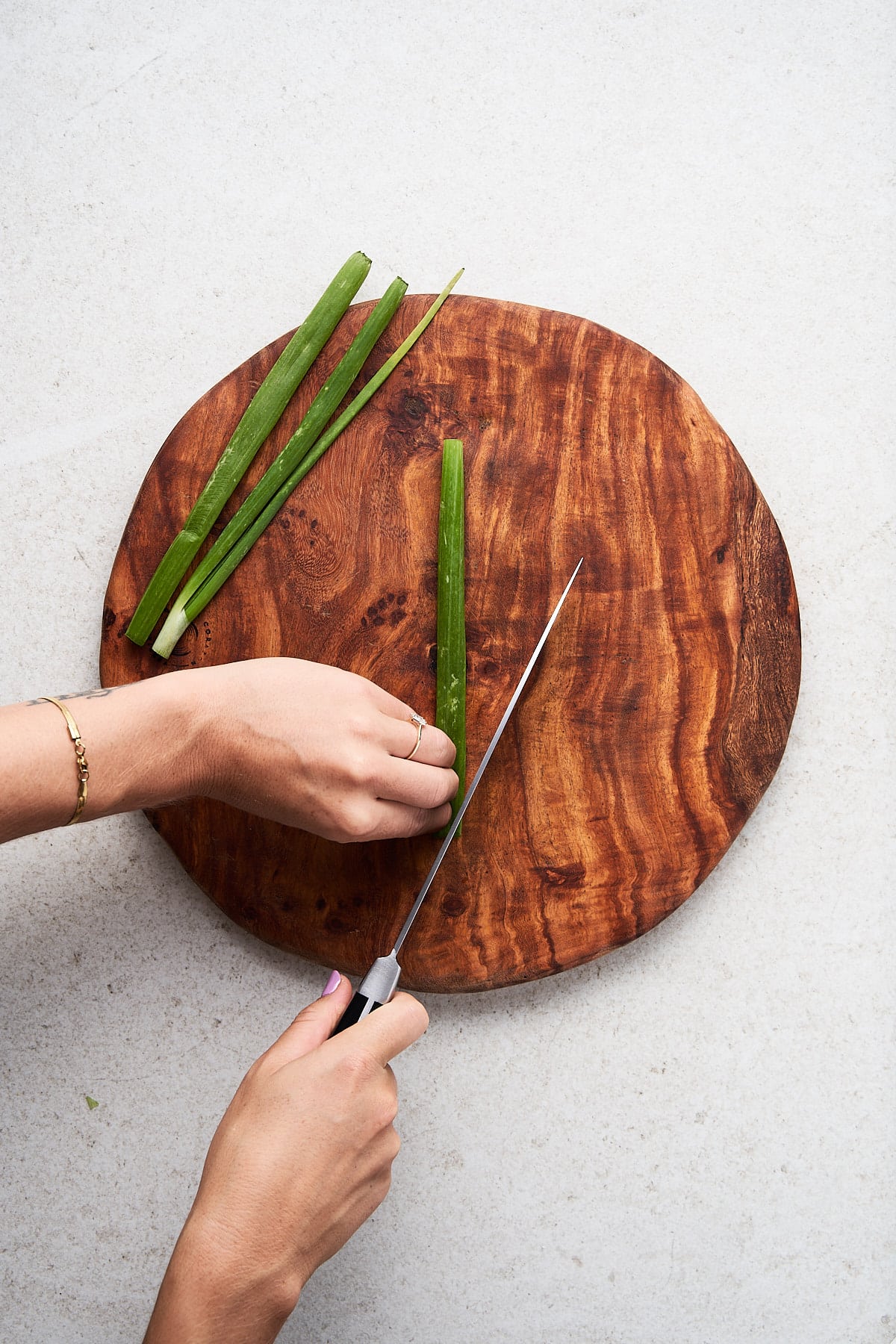
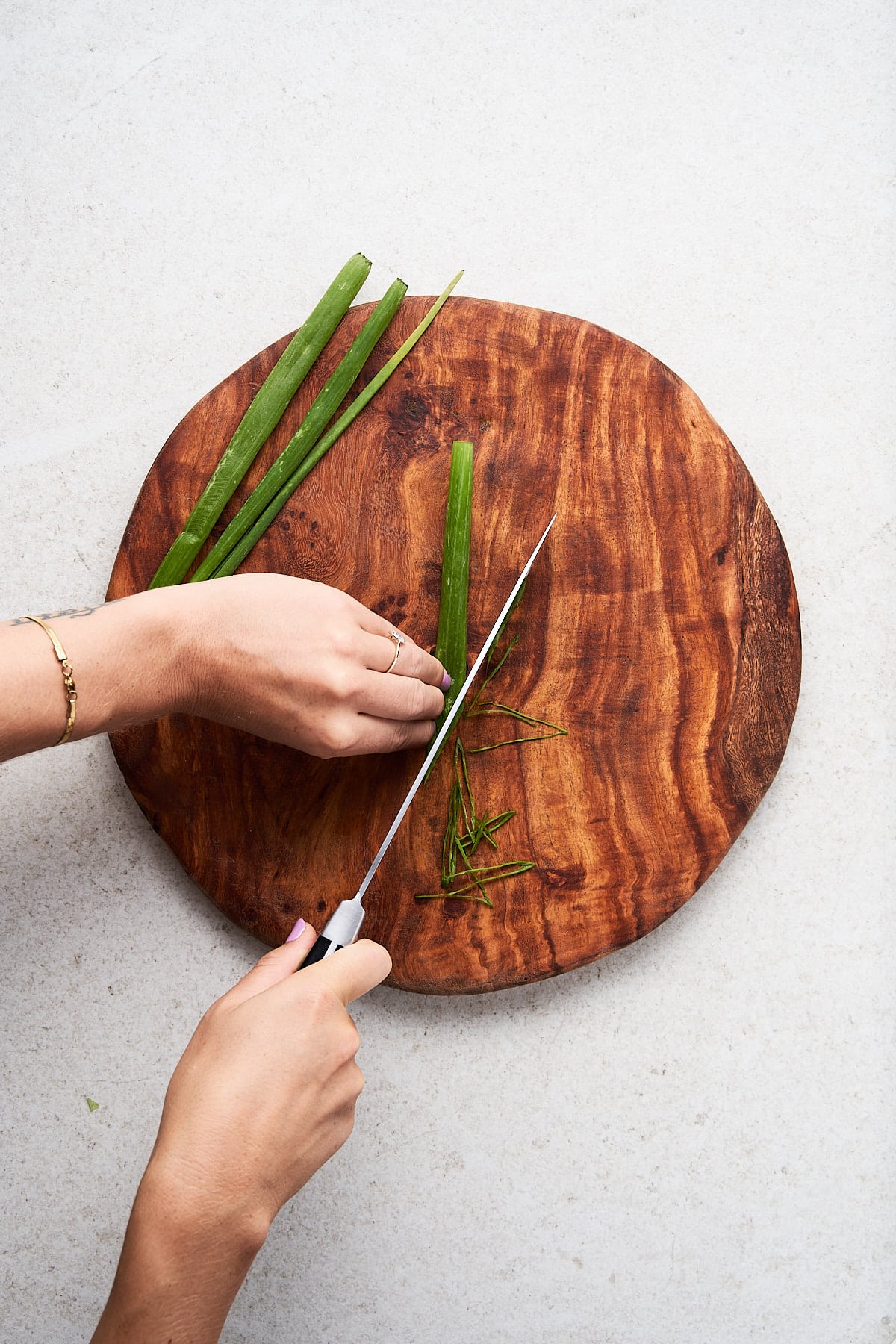
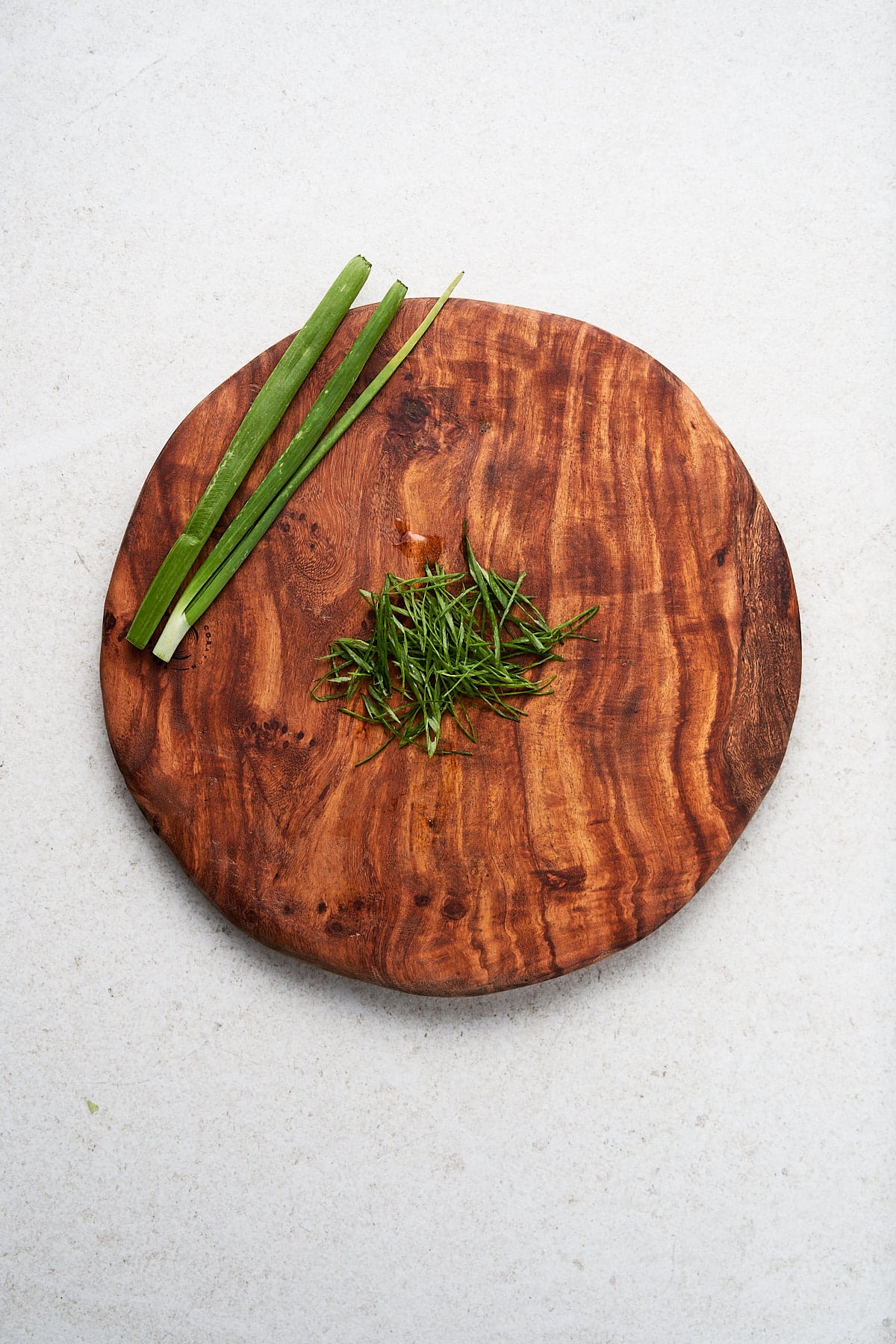
Step 3: Cut the spring onions
Next up, cut the white portion of the scallion!
Slice
Back to the bulb! If need be, peel away the outer layer and slice the spring onion in half lengthwise. Place each half flat side down, grip the top portion, then thinly slice it, dragging the knife tip towards you. Trim away the top portion, and you’ll be left with slices to be used in dishes like stir-fries.
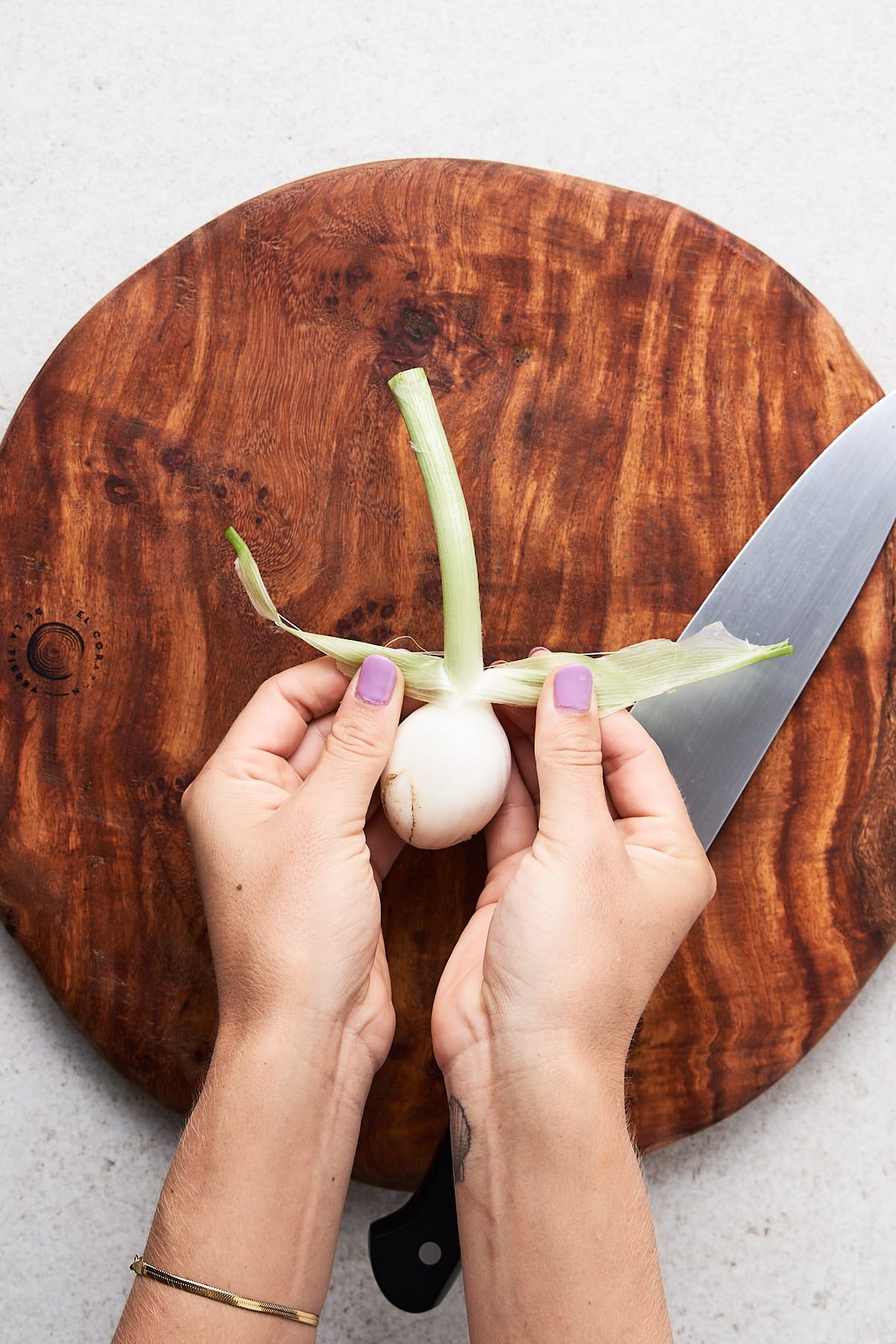
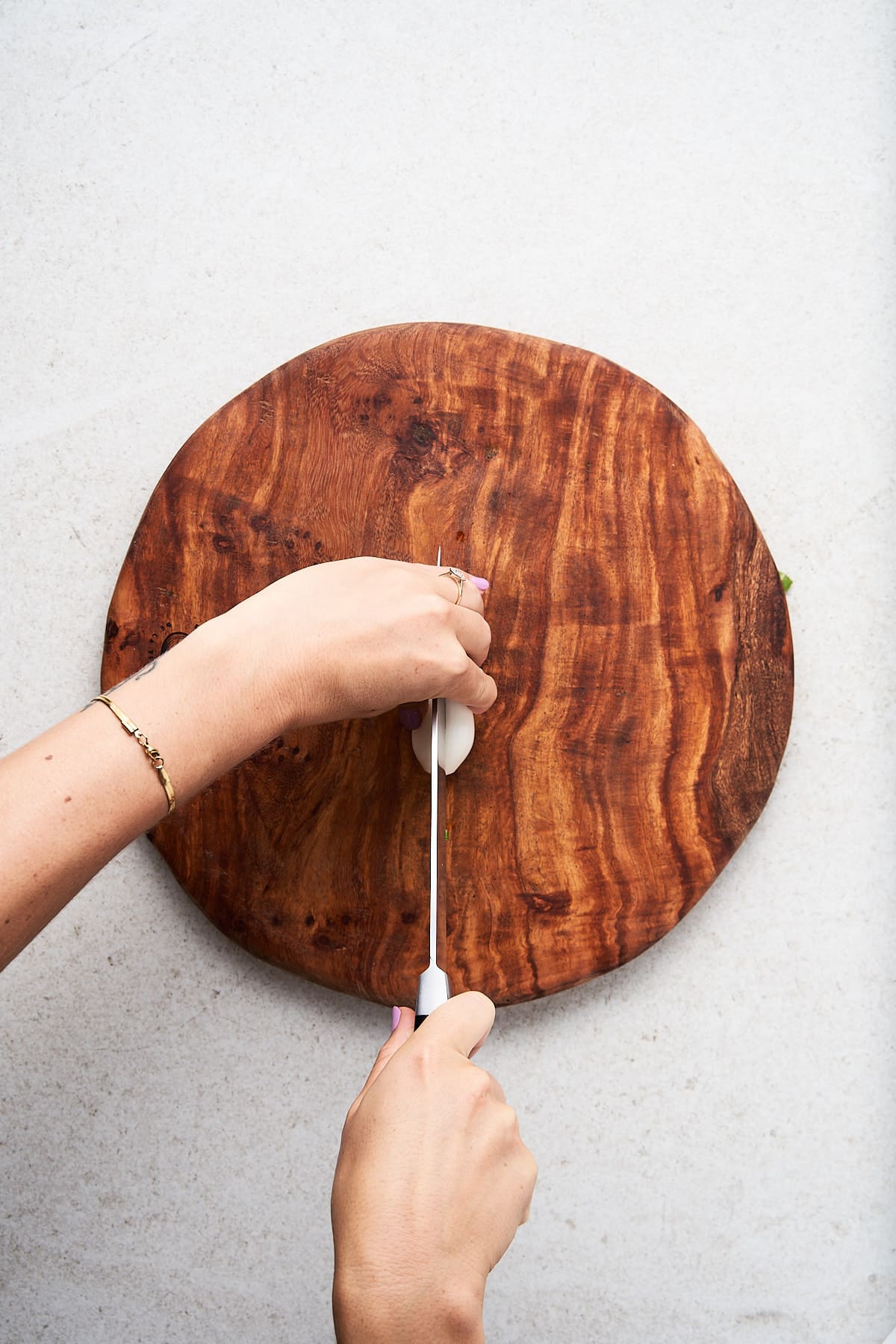
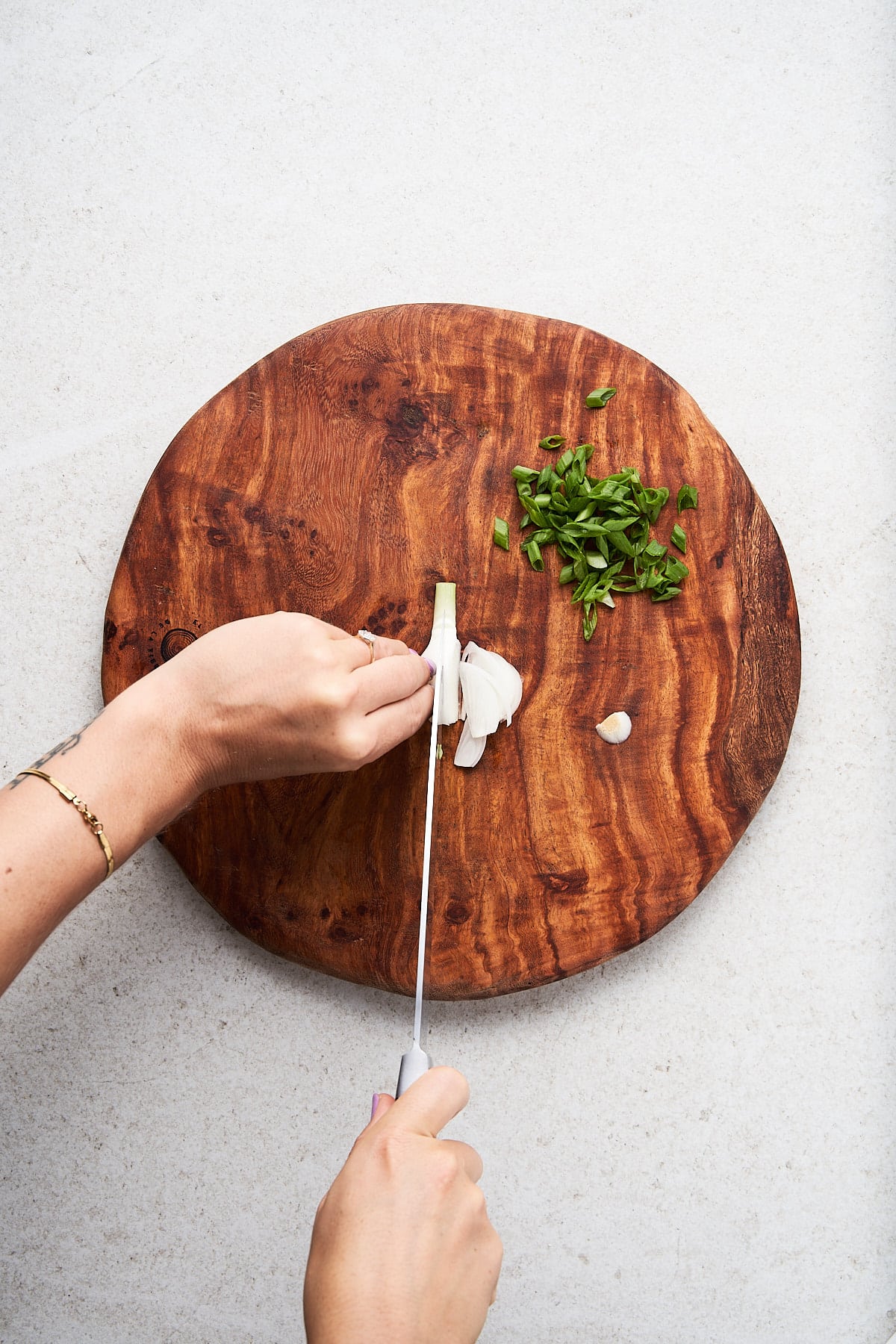
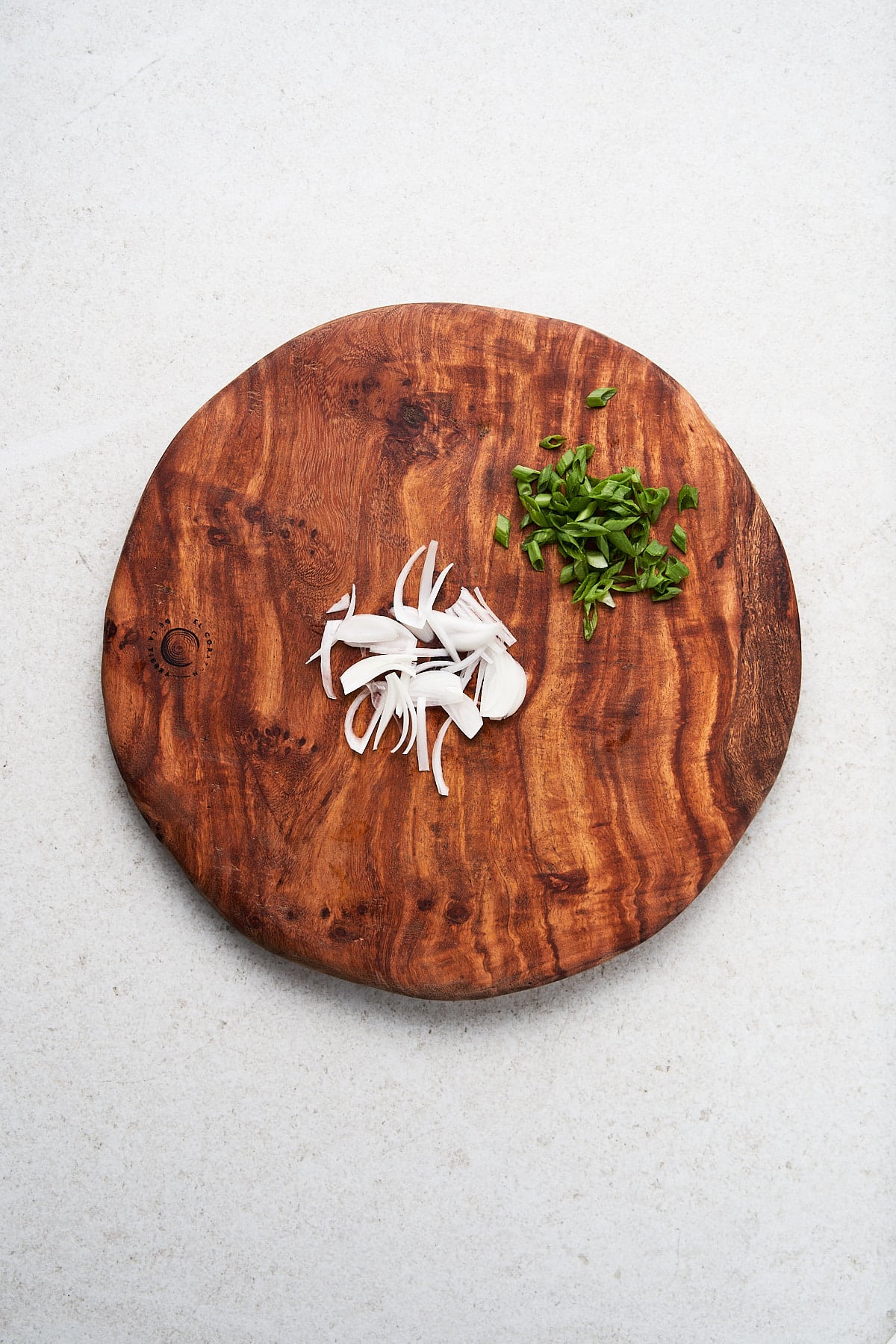
Dice
If you’d like diced onions, repeat the same steps as above, stopping before you trim away the top portion. Rotate the onion 90 degrees, grip the top portion to steady it, then cut it into small chunks using a rocker motion. Use the diced spring onion in soups, curries, and more!

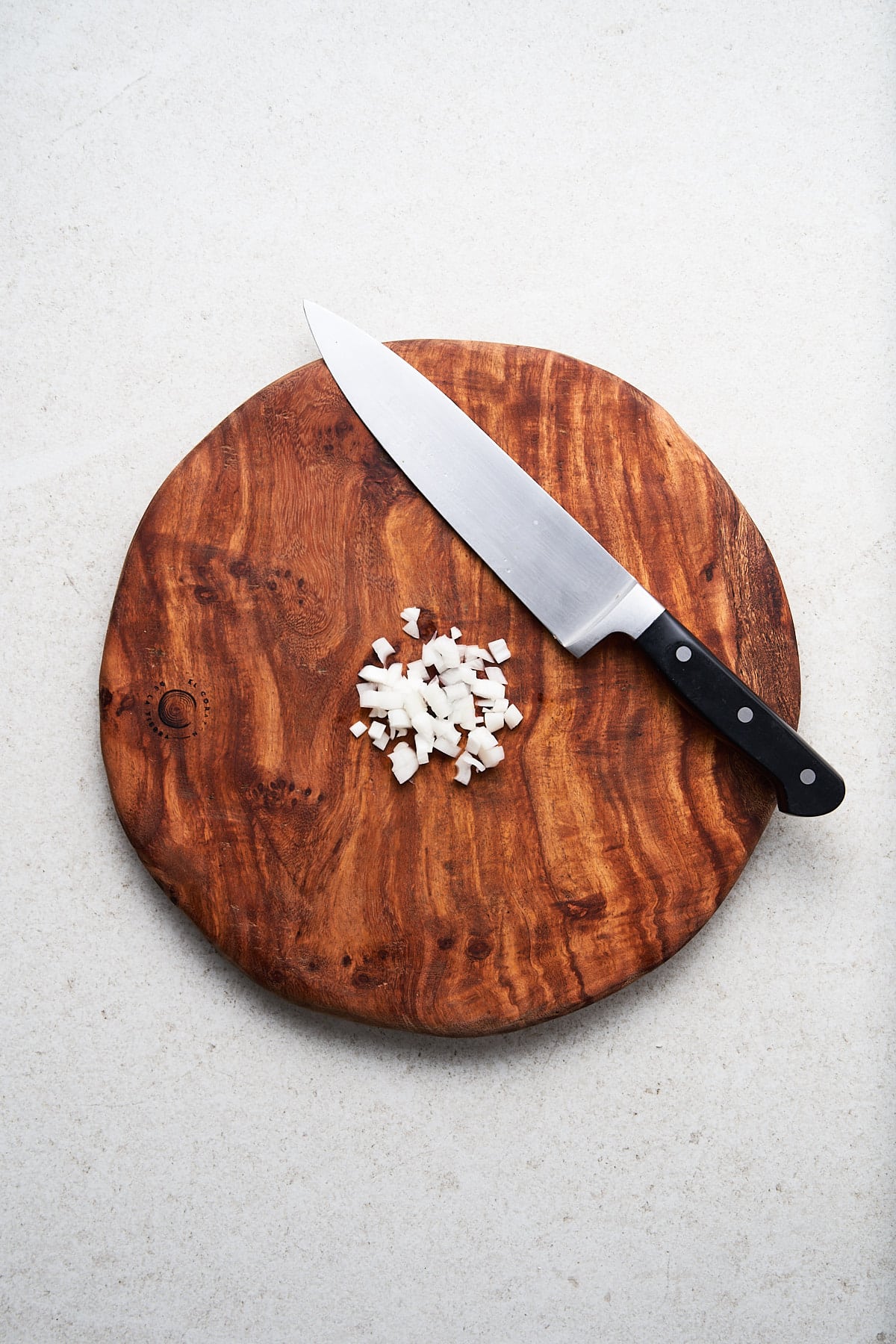
How to Use Green onions
After you’ve learned how to cut green onions, you may be wondering about all of the delicious ways to use them! A general guideline for using green onions is to save the stems for garnishes while incorporating the bulbs in the cooking process. Check out the following ideas for how to cook with both components.
Green onions
- Straight cut: On top of tofu salad, lettuce wraps, curries, pasta dishes, and baked potatoes. Or, mixed into mashed potatoes, tabbouleh, green onion pancakes, and biscuits.
- Bias cut: As a pizza topping, egg salad addition, soup or salad garnish, or noodle dish enhancer.
- Thin bias cut: To level up your ramen or poke bowl garnishes.
Bulbs
- Sliced: Sautéed in stir-fries, fried rice, or other recipes that call for white onions.
- Diced: Added to soups, stews, curries, etc.
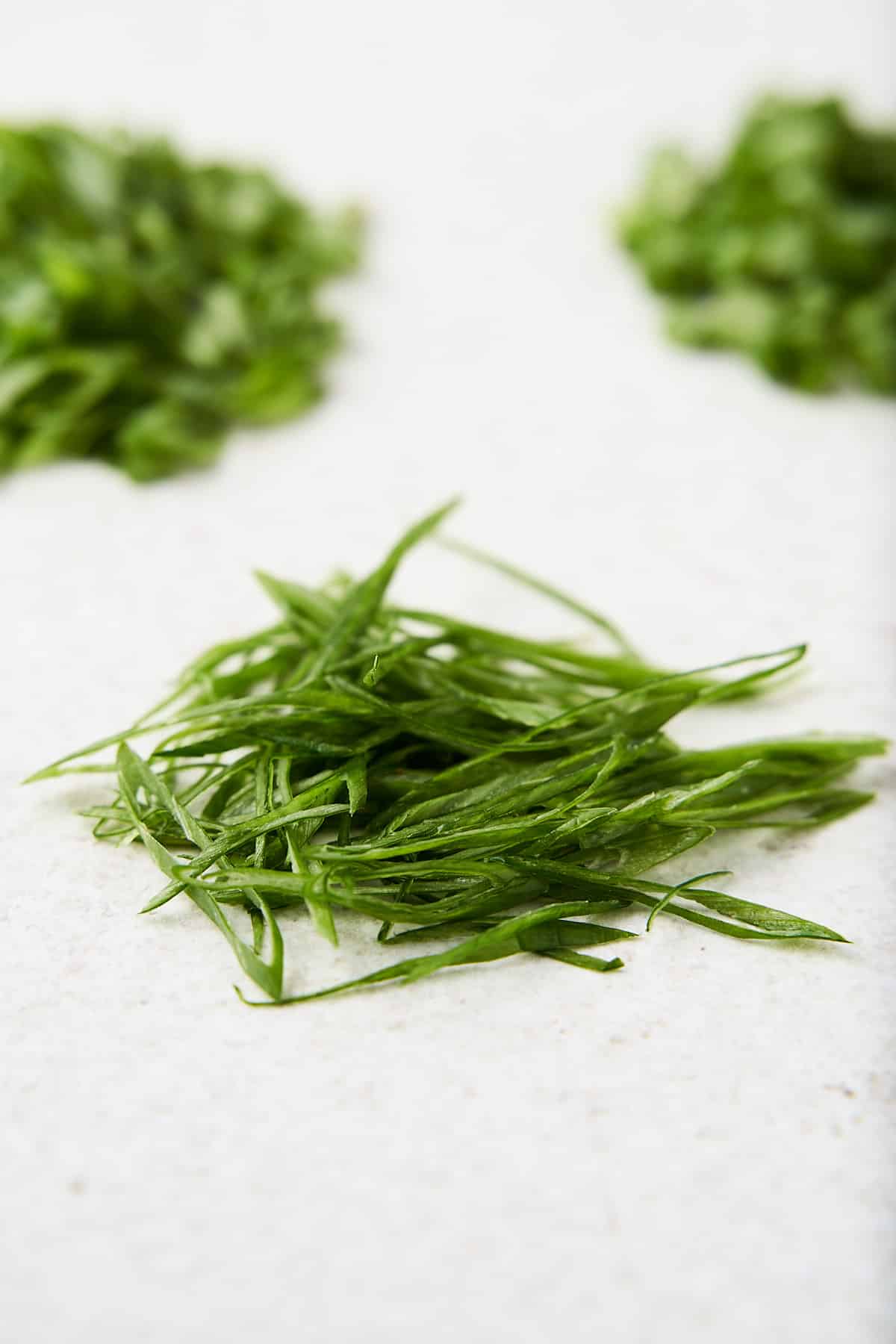
Storing Green Onions
Once you get your green onions home, follow these tips to preserve their freshness. That way, you can enjoy them for weeks to come!
- Fridge: Submerge the roots or bulb in a glass jar filled with water and cover it with a plastic bag. If the roots are missing, wrap the green onions in a damp paper towel, then add them to a plastic bag. Both options should keep the onions fresh for up to 2-3 weeks.
- Freezer: Pat the onions dry, dice them into small pieces, and add them to a freezer-safe container. For the best results, mix them 45-60 minutes later to prevent them from sticking together. Using this method, green onions should last in the freezer for up to 6 months.
How To pick fresh green onions
- Color: Look for green onions that have a vibrant green hue with minimal discolorations. Avoid bunches that have many slimy, brown, or dry stems.
- Touch: When you pick up a bunch of green onions, it should be able to hold itself upright. If all of the stems are floppy and falling over, the flavor won’t be as intense. However, if you remove the outer stems, you can still use the inner portion.
- Smell: The green onions should have a fresh onion scent with no rotten or off-putting aromas.
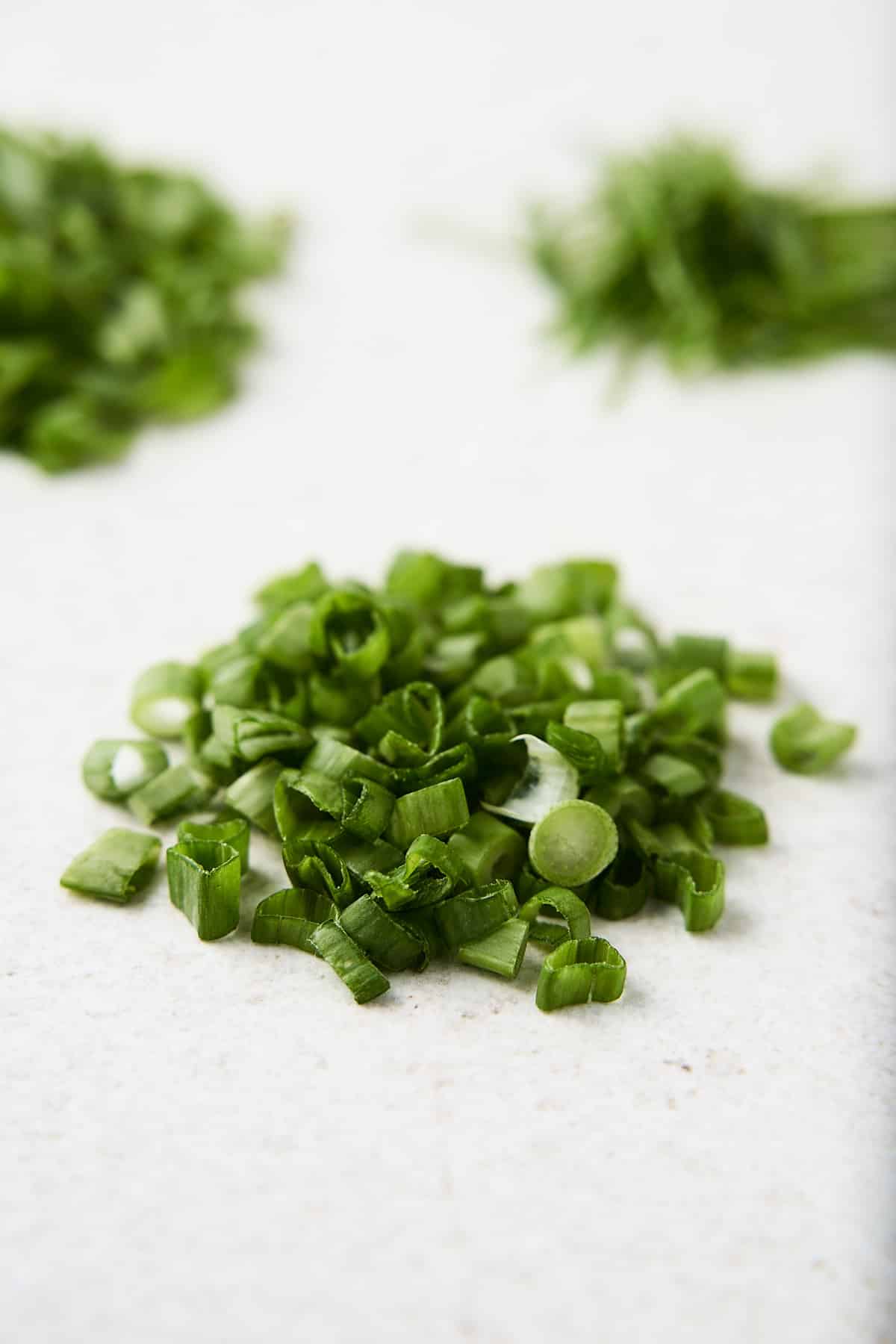
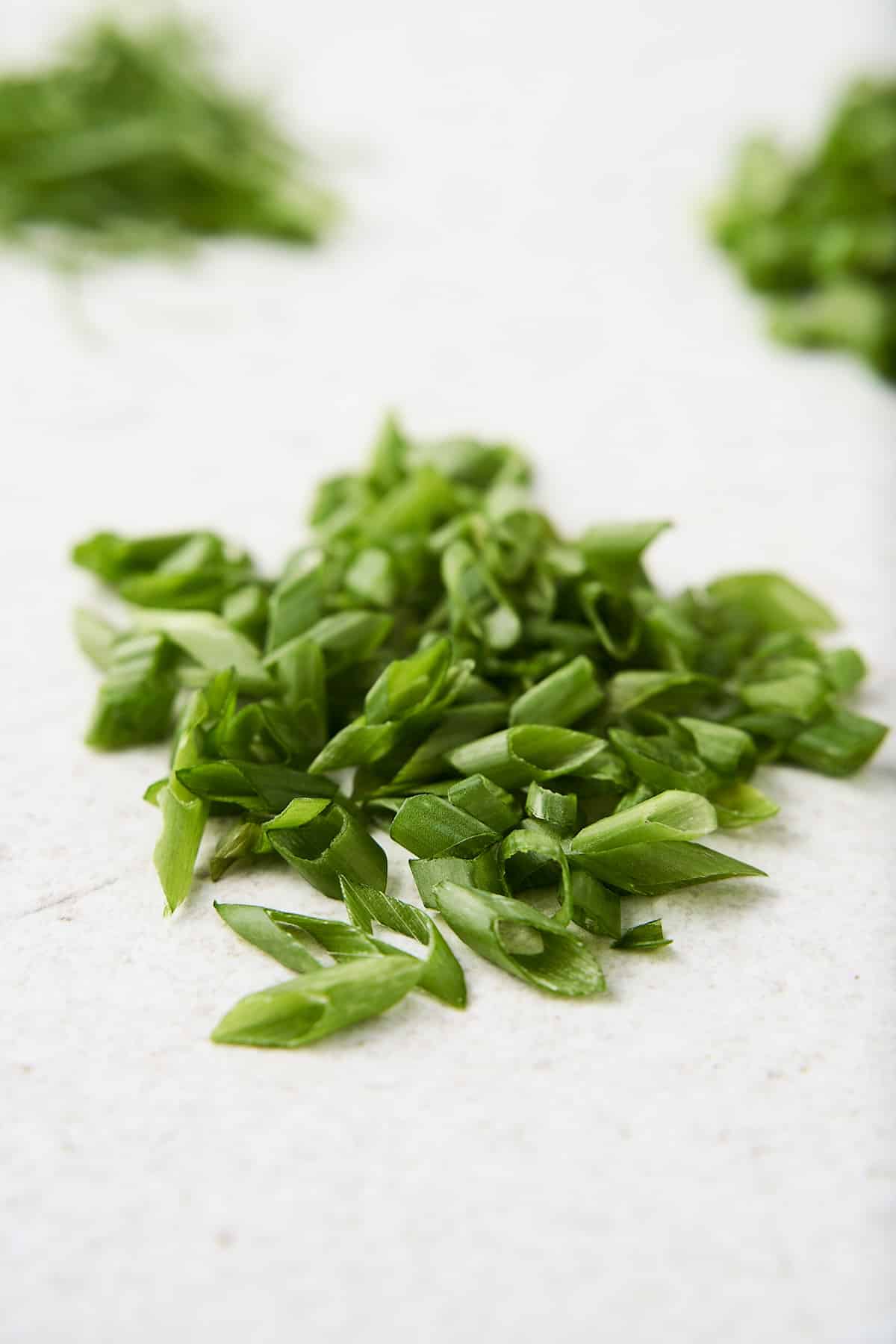
Nutritional Benefits
Although they come in a tiny package, green onions pack some serious health benefits:
Vitamin C, Magnesium, Potassium
Green onions contain vitamin C, magnesium, and potassium. Although each nutrient has various functions, they all play an important role in strengthening our immune system, which can have an impact on preventing disease.
Vitamin K
As an excellent source of vitamin K, eating green onions helps our bodies absorb adequate amounts needed for better heart and bone health.
Antioxidants
Green onions contain a special antioxidant called quercetin. This special plant compound has been shown to help reduce blood pressure, inflammation, and allergy symptoms.
Antiviral Properties
Allicin, a phytonutrient found in green onions, is known for its antiviral properties. Increasing our intake of phytonutrients like this may help combat illnesses.
Green Onion FAQs
When referring to a spring onion, the white part of a green onion is called the bulb.
Cut the end of the bulb or roots off the green onion. You can eat the bulb, but discard the roots. Everything else is edible but varies in flavor.
Yes, you can eat raw green onions. They’re mostly utilized this way in cooking, but you can also eat them cooked in fried rice, curries, and more.
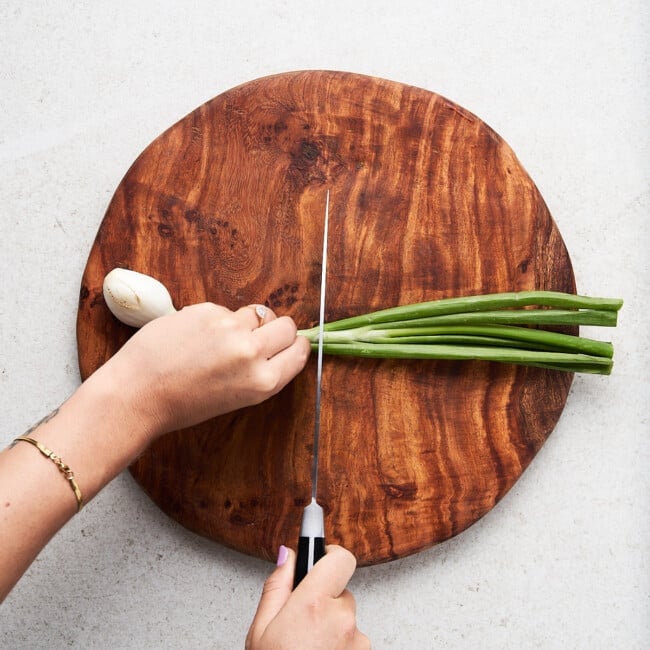
Ingredients
- 1 bunch green onions
Instructions
- Prep: Rinse away any large clumps of dirt, and peel away any slimy or wilty stems at the same time. Cut where the green stems meet the lighter, tougher portion of the onion. Cut the green onions in half to make a shorter bunch.
Cut Green Part
- Option 1 – Straight Slice: Place the green onion stems horizontally on your cutting board. Grip the bunch with your non-dominant hand, pushing your knuckles forward to protect your fingers. With a sharp chef’s knife, slice at a 90-degree angle to the stems, forming straight sliced green onions.
- Option 2 – Bias Cut: Grip the bunch with your non-dominant hand. Rotate your body or the bunch of green onions to about a 45-degree angle. Then, perform the same rocker motion to bias cut the green onions (angle cut).
- Option 3 – Thin Bias Cut: Place the green onion stem vertically on your cutting board, then rotate it slightly or move your body so your hips are not twisted. At a steep angle, begin slicing the onion by dragging the knife towards your body.
Cut White Part
- Option 1 – Slice: Peel away the outer layer and slice the spring onion in half lengthwise. Place each half flat side down, grip the top portion, then thinly slice it, dragging the knife tip towards you.
- Option 2 – Dice: Repeat the same steps as above, stopping before you trim away the top portion. Rotate the onion 90 degrees, grip the top portion to steady it, then cut it into small chunks using a rocker motion.
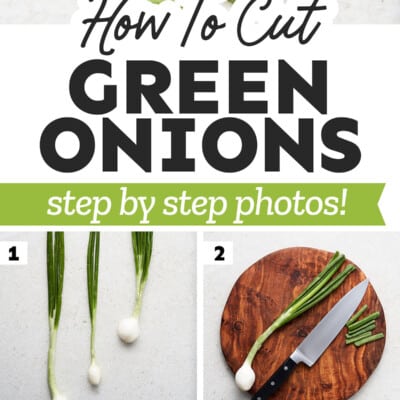
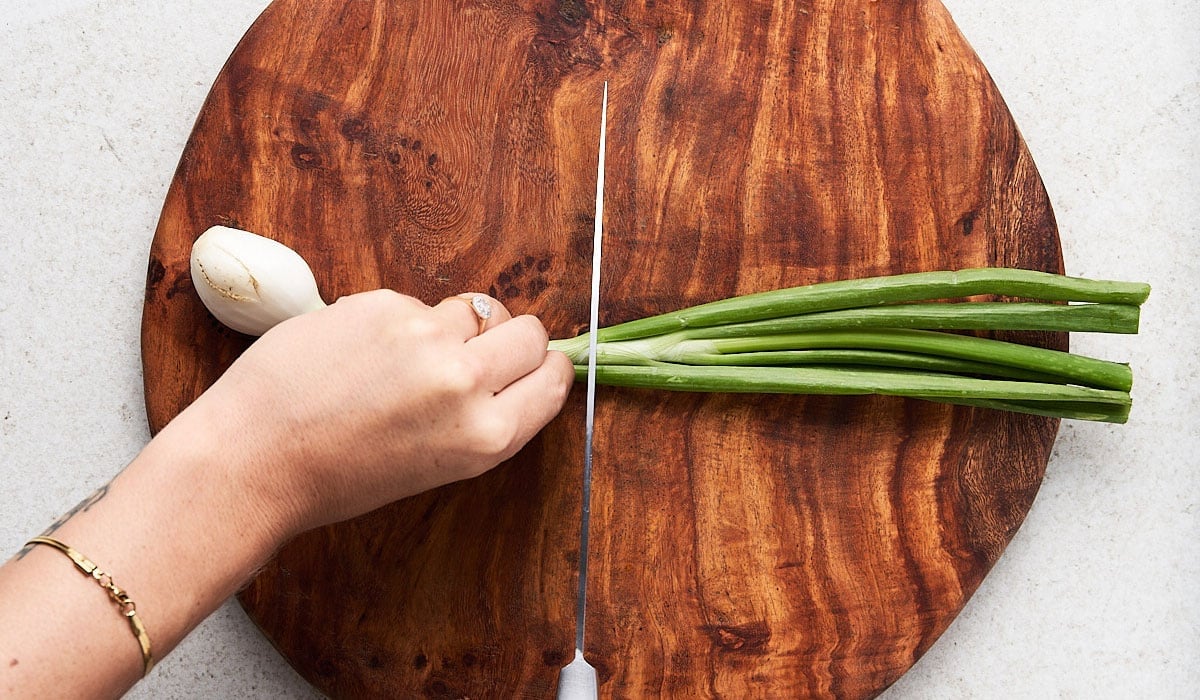
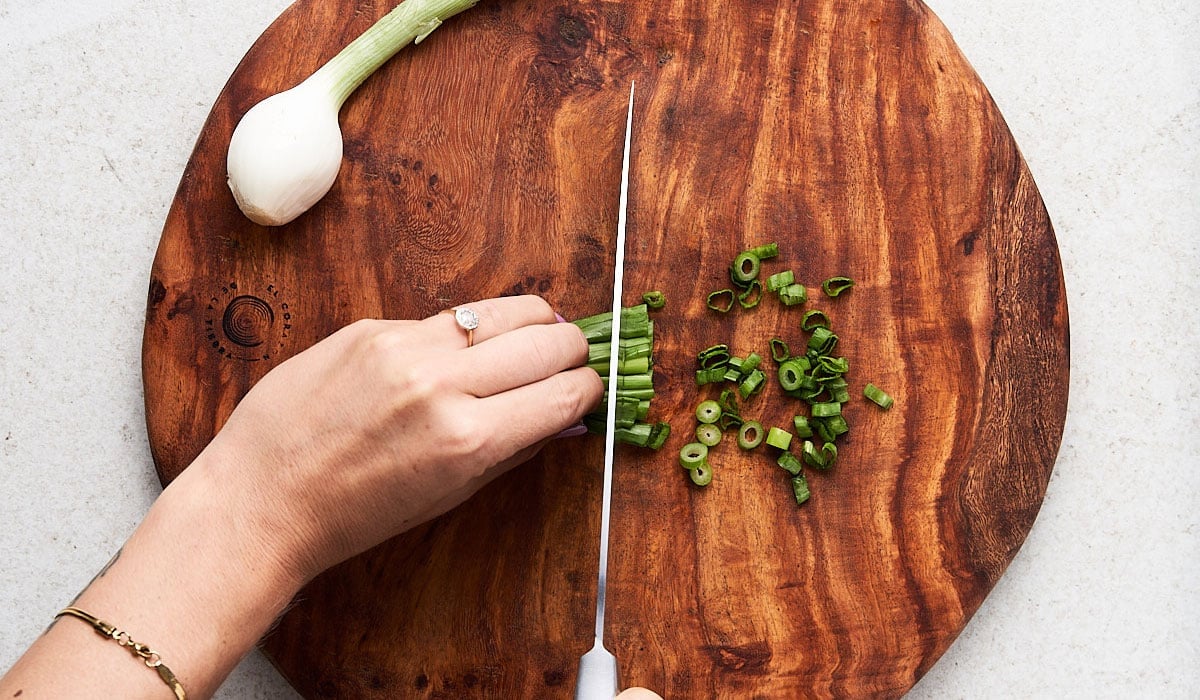
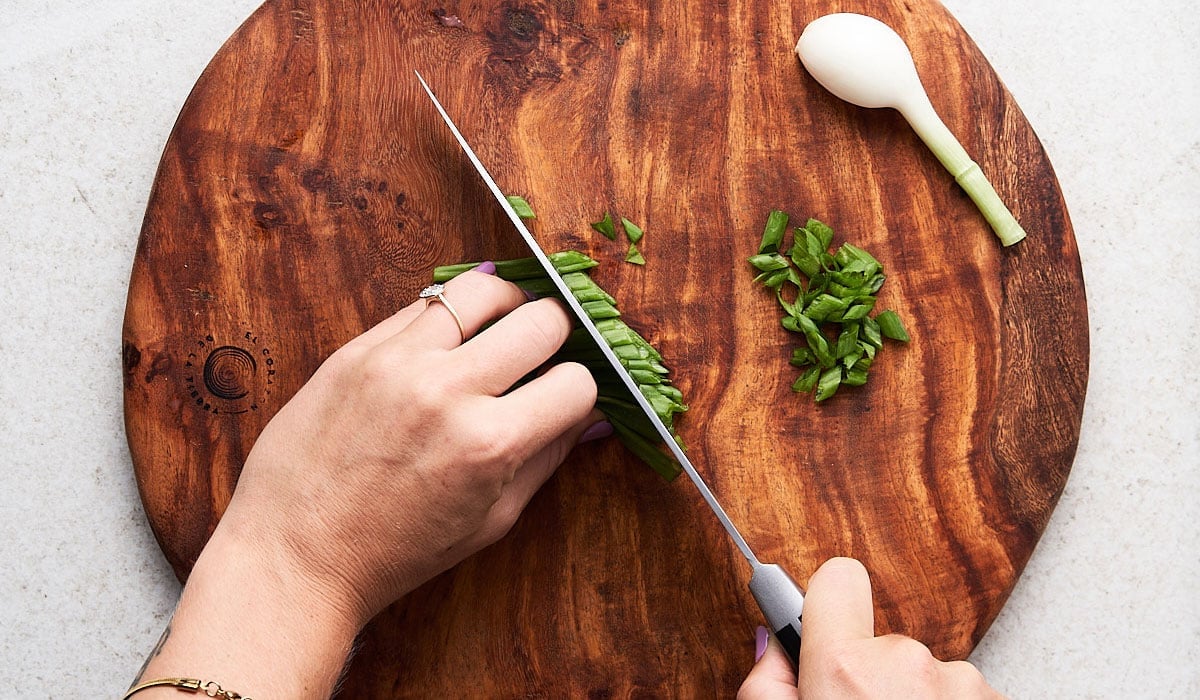
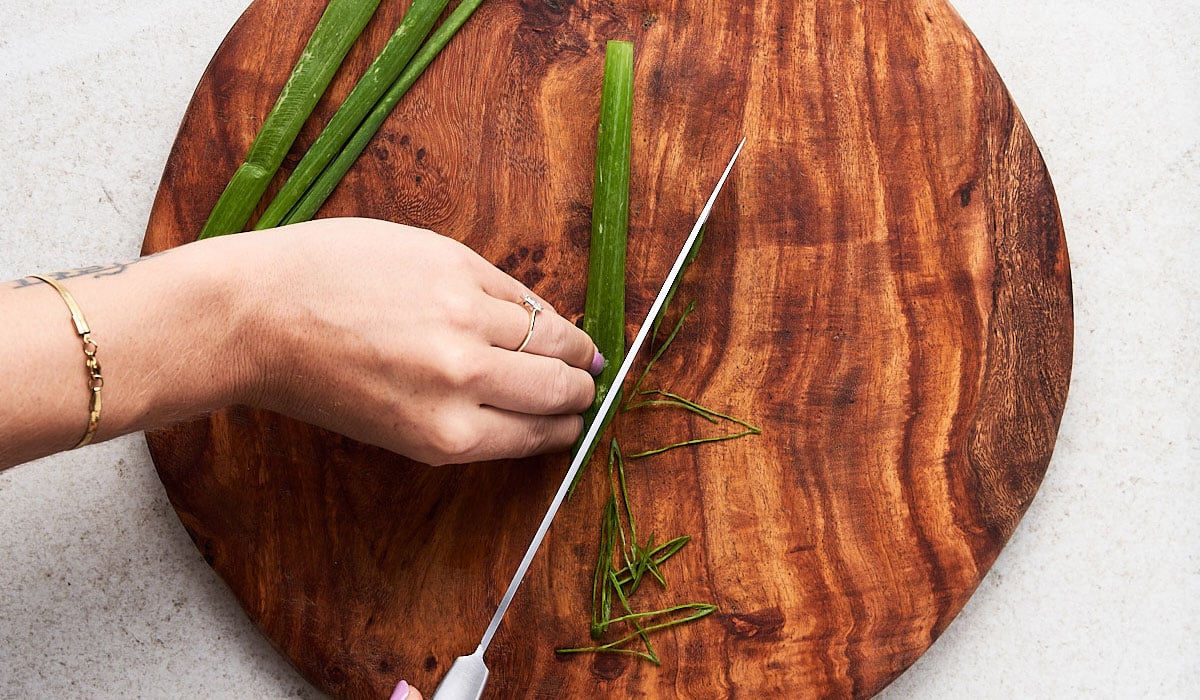
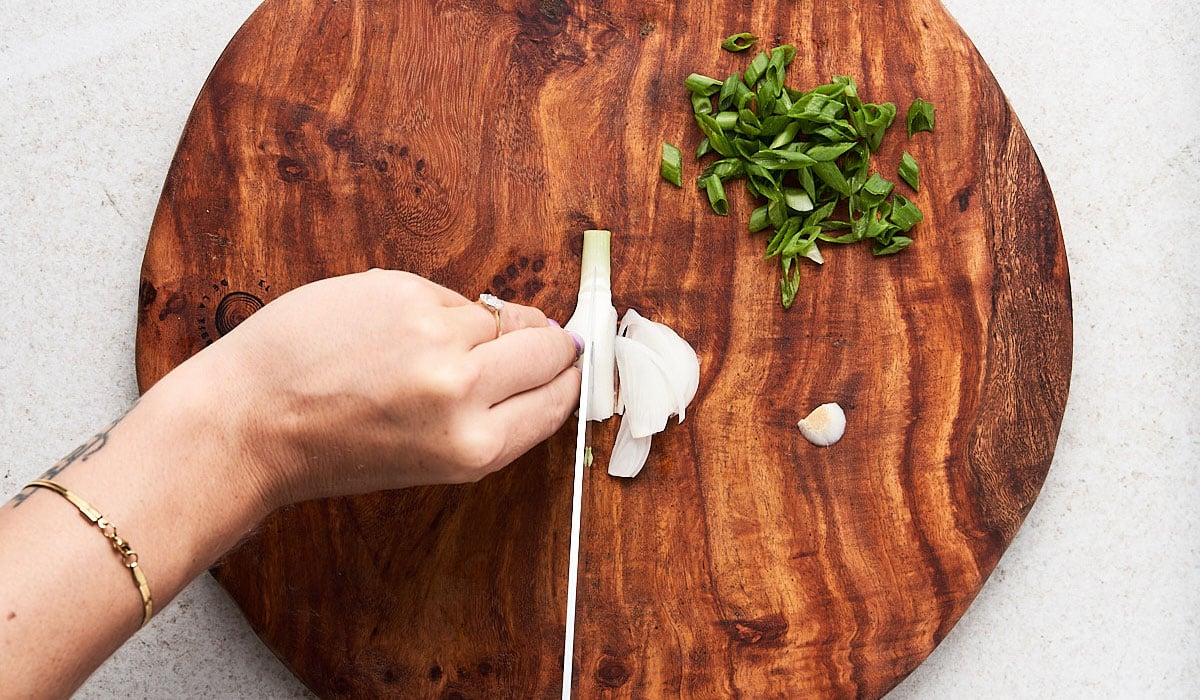
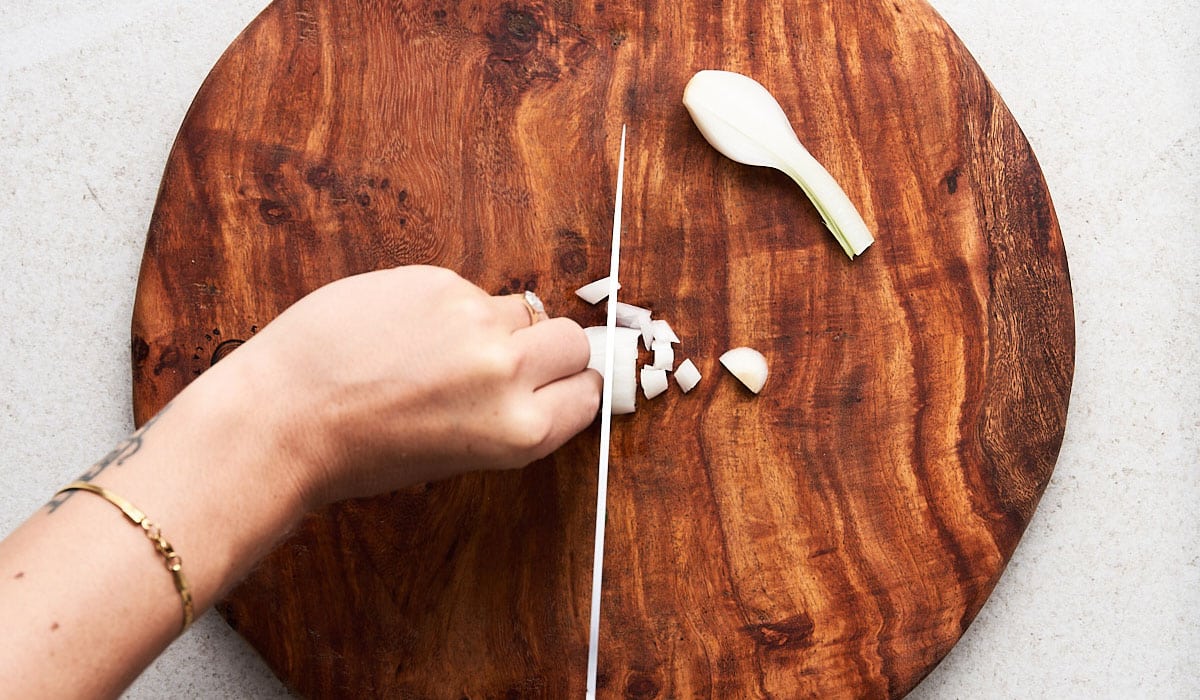
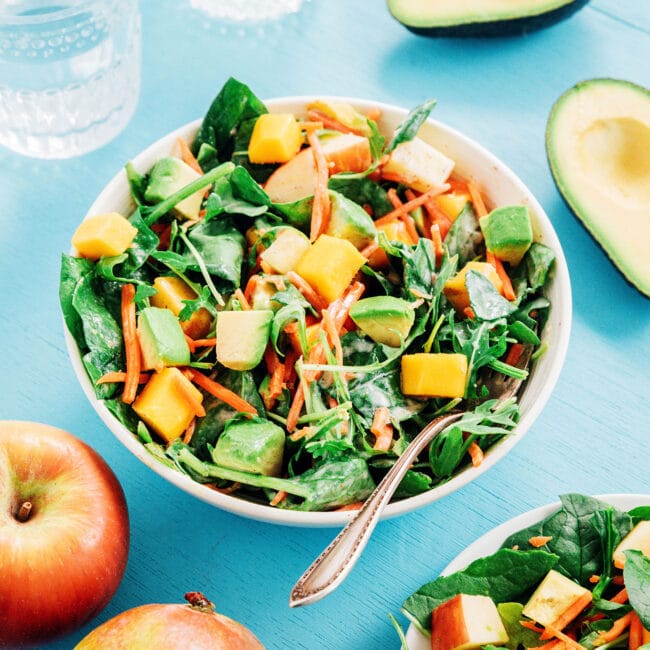


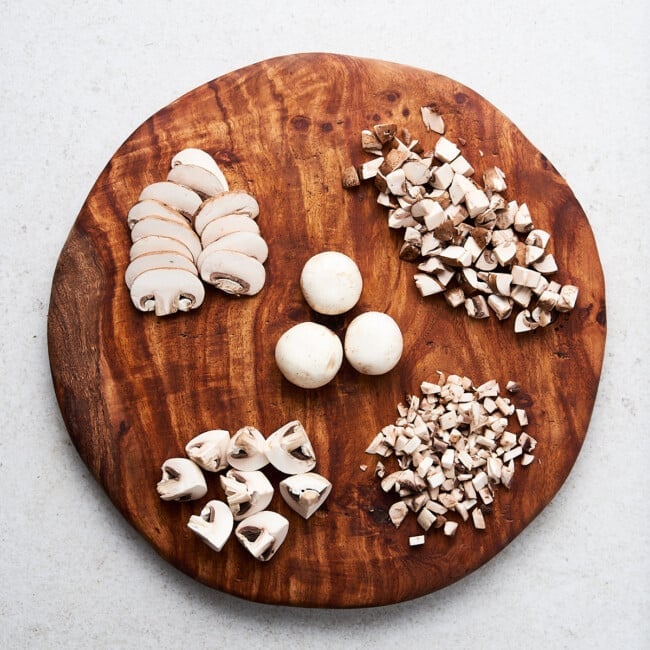
Leave a Comment